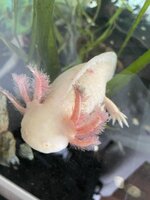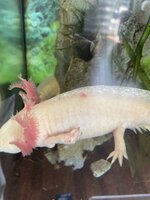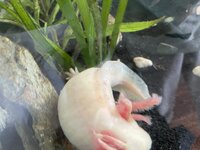Melina
Member
Hello!
Recently I noticed my axolotl has fungus…
Not to mention, we suspect that she is pregnant.
I tried doing salt baths, they seemed to help at first but it came back all the time. So I went to a fish store that I bought my axolotl from. They sold me some „Catappa leaves extract“ and they said it could help.
When I googled, it never said that it helps with fungus; so I’m not sure if either the internet is lying or the service..
I wanted to ask here, he also gave me Granulat/granules that I’m kinda suspicious of.. but anyways, it does say „medication for the prevention of fungi and parasites“.. personally, I never even heard of this thing and I’m not sure it’s save.
Other than that; is there any way to know that ur axolotl is pregnant?
I will be thankful for your help!
Recently I noticed my axolotl has fungus…
Not to mention, we suspect that she is pregnant.
I tried doing salt baths, they seemed to help at first but it came back all the time. So I went to a fish store that I bought my axolotl from. They sold me some „Catappa leaves extract“ and they said it could help.
When I googled, it never said that it helps with fungus; so I’m not sure if either the internet is lying or the service..
I wanted to ask here, he also gave me Granulat/granules that I’m kinda suspicious of.. but anyways, it does say „medication for the prevention of fungi and parasites“.. personally, I never even heard of this thing and I’m not sure it’s save.
Other than that; is there any way to know that ur axolotl is pregnant?
I will be thankful for your help!



